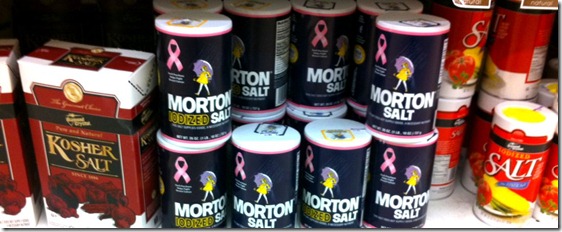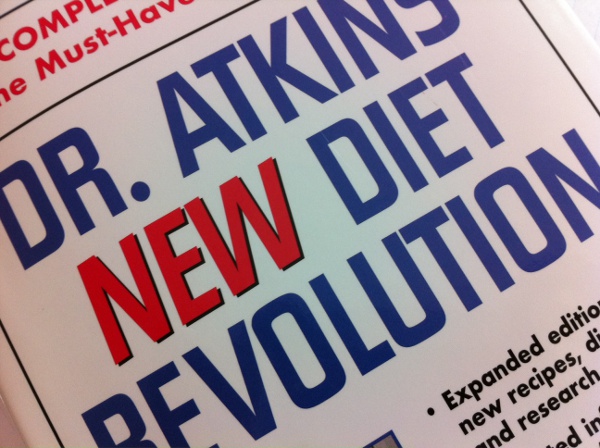Is Sea Salt Healthier than Table Salt?
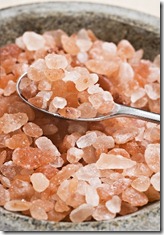 I’d like to consider myself a savvy consumer, at least when it comes to food. So it’s a bit annoying when I realize that I’m buying something just because the packaging is pretty or I saw a flashy advertisement selling it to me. However, I’ve got to occasionally give credit where credit is due…
I’d like to consider myself a savvy consumer, at least when it comes to food. So it’s a bit annoying when I realize that I’m buying something just because the packaging is pretty or I saw a flashy advertisement selling it to me. However, I’ve got to occasionally give credit where credit is due…
There is a certain amount of advertising genius behind the "natural sea salt movement." I don’t watch too much Mad Men, but the advertising story surrounding salt seems so made-for-TV that I can almost envision a Madmen episode on this (feel free to contact me Hollywood)!
I’m pretty sure that the advertising discussion for salt must have gone something like this:
“OK Joe, how should we advertise this salt?”
“Well, we’ll claim that it’s the most exciting new culinary invention in decades!!”
“But Joe, it’s been around for millennia…”
“Um, how about we claim that salt is so scarce that only a few lucky individuals will have the opportunity to enjoy it?”
“But JOE! EVERYONE can buy it already!”
“I’ve got it – We’ll create new kinds of salt. We’ll even make some of them PINK!”
And lo and behold, the salt guys had their “Aha” moment. Think about this for a minute – when you go to a normal grocery store, there are approximately 322 different types of salt on the shelves. Really – go count them.
The salt industry went and CREATED what are essentially new, better, and more desirable salts. Who would otherwise pay 10 times the normal price of salt just because the salt granules were PINK?? I’m sure, all the way back in 1971 when Starbucks was born, it was also crazy to think that anyone would pay $3 for a cup of coffee, but Starbucks seems to be doing just fine.
Now, the bigger question is: Should we be paying more for certain types of salt?
Salt, the Other Kind of Salt, and the Other Kind of Salt
There are 3 main types of salt that you’ll find at the store: table salt, sea salt, and kosher salt. (There’s also unrefined salt, which is generally sea salt that hasn’t gone through a refining process – I’ll get to unrefined salts later, but note that it’s only unrefined if it’s specifically labeled as such.) Most table salt is that cheap fine white powder (think Morton). Then there’s those pink rocks and the exotic salts – they’re usually all different types of sea salt, and when I say different types, I actually mean similar chemical compounds placed in pretty jars with labels that make you think each one of them is “special.” And kosher salt is, well, kosher salt – it’s also labeled very clearly as kosher salt!
α, β, ϒ Let’s Analyze Salt: Is sea salt or kosher salt better chemically than table salt? Well, salt is simply the chemical compound, NaCl (sodium chloride). No matter what type of salt you buy, table salt, sea salt, and kosher salt each have at least 97% NaCl (it’s part of the Codex Alimentarius Standard). So whether you’re spending $1 on that huge bag of table salt or $10 on that tiny jar of cute pink crystals, you’ll be consuming 97% the same thing.
What’s the other 3%? You’re thinking that maybe the other 3% makes up for that 10-fold difference in price? That’s certainly what the salt industry seems to want us to believe. In truth, however, that other 3% is not so important or crucial as we might hope:
In table salt, that other 3% is usually just more NaCl, along with a tiny bit of anti-caking ingredients.
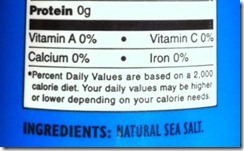 In sea salt, that other 3% is often other trace minerals such as magnesium, potassium, sulfates, and bromides. You’ve probably heard that you need those minerals and that’s why sea salt is so much better for you, but let’s step back just a bit… They are called “TRACE” minerals for good reason – there’s only TRACE amounts of them in the salt!
In sea salt, that other 3% is often other trace minerals such as magnesium, potassium, sulfates, and bromides. You’ve probably heard that you need those minerals and that’s why sea salt is so much better for you, but let’s step back just a bit… They are called “TRACE” minerals for good reason – there’s only TRACE amounts of them in the salt!
Kosher salt, as I’ll explain below, can be either table salt (derived from underground deposits) or sea salt, meaning that the other 3% in Kosher salt matches either table salt or sea salt, as applicable.
At this point, I need to take a quick detour to talk about unrefined salts, which can be a subcategory of table salt, sea salt, or kosher salt. Unrefined salts are actually a fair amount different from the usual refined salts that you find in most supermarkets. Unrefined salts often contain much less NaCl and much more trace minerals. For instance, a typical unrefined salt might be 70% NaCl and 30% other minerals. That’s good right? Yes, but before you run off to the store to get your unrefined salt in order to bulk up on your lost minerals, keep in mind that you’re still going to need to eat A LOT of unrefined salt to actually have it make any difference. You’d probably be better off spending the money on some multi-vitamins. Otherwise, you’ll just be overloading on sodium and remain deficient in everything else!
Surely there must some differences in the manufacturing processes of different salts, right?
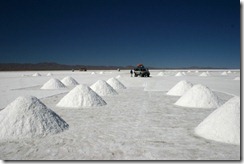 Although the labels make the salt sound so exotic (Hawaiian black lava sea salt is definitely a winner in my mind), salt really comes from just two general places – salt mines (deposits of salt underground) or evaporated seawater. The country that the salt comes from really doesn’t matter – it’s the difference between drinking sea water in Florida versus in Sicily: it’s all just seawater. Table salt is mined from salt deposits underground. Sea salt comes from the sea (shocking!) – it’s evaporated seawater.
Although the labels make the salt sound so exotic (Hawaiian black lava sea salt is definitely a winner in my mind), salt really comes from just two general places – salt mines (deposits of salt underground) or evaporated seawater. The country that the salt comes from really doesn’t matter – it’s the difference between drinking sea water in Florida versus in Sicily: it’s all just seawater. Table salt is mined from salt deposits underground. Sea salt comes from the sea (shocking!) – it’s evaporated seawater.
Kosher salt can come from either underground deposits or seawater – what’s “special” about the salt is that it contains no additives (e.g., no iodine), and it has been certified as kosher by a rabbi or other authorized organization. Kosher salt originates from preparing foods such as meats according to Jewish law, which prohibits the consumption of any blood in the meat. The large granules of kosher salt is therefore perfect for drawing out traces of blood from the meat. If fine granules of table salt was used, it’d quickly dissolve once placed on the meat resulting in very salty meat. Kosher salt is often advertised as “better” because it’s pure with no additives. However, the main additive that they’re talking about is iodine. Remember those seriously disgusting lumps protruding from the necks of people with goiter? Yeah, that’s called IODINE DEFICIENCY! Iodine was especially added into salt to help with this problem, much like fluoride is added into tap water to prevent tooth decay.
So I’m confused now, is there ANY real difference?
Surprisingly, yes – but just not for the reasons that advertisers (those genius madmen) wanted you to believe. There is a distinct difference in the texture and, to some degree, the taste. Table salt is much finer than sea salt or kosher salt, which means that there is a lot more salt in one tablespoon of table salt than of sea salt or kosher salt. So when substituting one type of salt for another when following a recipe, you should remember that 1 tablespoon of kosher salt/sea salt = 3/4 tablespoon of table salt (although this equation can vary a bit as the granule sizes often vary from brand to brand). Table salt is also better for baking as its fine granules mix more easily into the dough. As to taste, some people say that table salt has a sharper taste than kosher or sea salt. I personally tend not to eat salt all by itself, and once blended into the food, it really just tastes salty to me.
So what should you do when you see one of those carefully manicured jars of softly colored rocks of salt screaming “BUY ME, BUY ME – I’m Natural, I’m Healthy, I’m way Better Than The Rest” as you walk down the supermarket aisle? Take it with a grain of salt – it’s all salt! (Don’t cringe and shake your head now – you had to know that I’d squeeze that joke in!)
Empty Fridge, Empty Stomach
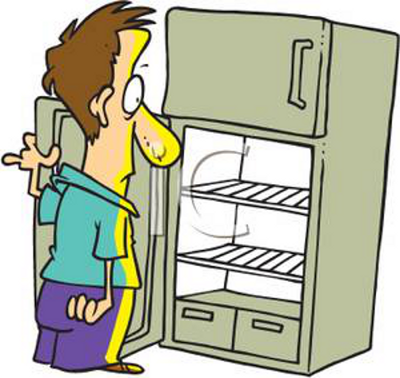
Empty Fridge, Empty Stomach
When I first started trying to be healthy and low-carb, I was always hungry when I got home at night, and the question on my mind was always: “What should I eat for dinner?” It was a hard question to answer especially when my fridge was empty and my list of “should eat” foods didn’t correspond too well with the “want to eat” foods (i.e. I wanted to eat cake – who doesn’t??). These were pretty serious problems, especially when you’re a ravenous monster exhausted from an entire day of work! Keeping on any diet (whether low carb or otherwise) is practically impossible when you’re faced with hunger pangs, an empty fridge (or a fridge full of foods not on your diet), and a fixation on cake (I’m also up for brownies, cupcakes, ice-creams, if they’re good). It’s like asking for your diet to be broken! Well, it’s taken me months and cake still tempts me, but I’ve come to realize that there are three important practices that have made healthy eating a lot easier to stick with (at least when you’re at home!):
1. Throw Out the Bad Food It’s practically impossible to eat unhealthily in my apartment – there’s no sugar, no flour, no pasta, no potatoes, no rice or other grains, no fruit juice, and definitely no cake (I’ve searched!). There is therefore no temptation in front of me at home. Of course, my mind still tempts me, but luckily I’m generally way too lazy to make the effort to go out and buy bad food (although the 7 Eleven on my street corner does do some midnight business from me unfortunately)! But if you’re going to cheat and buy a pack of cookies, be sure to throw out the leftovers (if any) so that you’re not tempted to continue to eat them the next day!
2. Stock Up on Good Food If you just have an empty fridge, then no amount of willpower will stop a hungry and tired you from going out to buy a bunch of “bad” foods. Go to the store when you’re NOT hungry and stock up on “healthy” provisions. What can you buy? There are the staple items: coconut milk, protein powder, eggs, a variety of vegetables (no potatoes or carrots) and fruits. You can also stock up on nuts, dark chocolates and cheese as snacks to take to work. You’re probably thinking that my shopping list doesn’t sound like too great of a meal, but wait, there’s a third step still!
 3. Cook Lots on the Weekends and Watch TV I hear the groans coming now: “I can’t cook,” “my food tastes like ****,” “cooking is [insert your complaint here, e.g., boring, tiring, annoying].” Yeah, I know – I made those same old excuses myself! I’ve had plenty of cooking disasters – I still do (I burnt some vegetables two days ago) – and I’ve cooked plenty of dishes that I couldn’t bring myself to eat (you only see the recipes that worked!). But, it’s honestly not that awful. There are many trustworthy recipe websites where you can read reviews of how the food turned out. Many recipe sites like allrecipes.com have user ratings for all the recipes and some recipes even provide a carb and calorie count. Pick easy recipes that get good reviews – there are quite a lot of them. And then it’s just a bit of trial and error. Make large portions over the weekend and store in the fridge to eat over the week. I’ve found cooking to be quite relaxing actually – it allows me to be a bit creative on occasions and most importantly gives me an excuse to watch tv without feeling like I’m wasting my free time! I’m in a job where I sit for most of my waking hours so getting to be standing in the kitchen is a calorie-burner in itself! And lastly, cooking your own food is way cheaper and cleaner than eating out or buying prepared foods. Have I convinced you yet?
3. Cook Lots on the Weekends and Watch TV I hear the groans coming now: “I can’t cook,” “my food tastes like ****,” “cooking is [insert your complaint here, e.g., boring, tiring, annoying].” Yeah, I know – I made those same old excuses myself! I’ve had plenty of cooking disasters – I still do (I burnt some vegetables two days ago) – and I’ve cooked plenty of dishes that I couldn’t bring myself to eat (you only see the recipes that worked!). But, it’s honestly not that awful. There are many trustworthy recipe websites where you can read reviews of how the food turned out. Many recipe sites like allrecipes.com have user ratings for all the recipes and some recipes even provide a carb and calorie count. Pick easy recipes that get good reviews – there are quite a lot of them. And then it’s just a bit of trial and error. Make large portions over the weekend and store in the fridge to eat over the week. I’ve found cooking to be quite relaxing actually – it allows me to be a bit creative on occasions and most importantly gives me an excuse to watch tv without feeling like I’m wasting my free time! I’m in a job where I sit for most of my waking hours so getting to be standing in the kitchen is a calorie-burner in itself! And lastly, cooking your own food is way cheaper and cleaner than eating out or buying prepared foods. Have I convinced you yet?
EXAMPLE: Food For a Week In case you’re still not a believer (and I sense a lot of disbelief here), here’s an example of what I would cook for an entire week for 2 people over the course of 3-4 hours on Sunday (while watching some tv crime drama on Netflix). 
- Boil a dozen eggs, peel, let cool naturally and store in a container in the fridge. There are various ways you can eat boiled eggs e.g. chop up and put in a green salad, chop up and mix with some mayo and mustard and salt to make an egg salad, chop up and mix with soy sauce, sesame oil and a touch of hot sauce, or just eat it by itself (body-builders do it all the time!).
- Buy some washed spinach, grape tomatoes, canned tuna and canned or jarred olives. These are simple to store and you can make a salad in less than 5 minutes with these. As a dressing, try ranch or Caesar or simply olive oil, vinegar, and salt.
- Make some bunless burgers. I’m not a big fan of the beef taste, so I like to put some yellow onions, green onions, sometimes a leek, some garlic, ginger, a bit of garlic and onion powder, and some salt (or basically whatever you want – blue cheese also works well!). You can get grass-fed ground beef at Wholefoods, and it’s easy to just mix the spices and vegetables into the beef. You don’t have to cook it on a BBQ grill – I use a Foreman grill sometimes, other times I pan-sear it in some coconut oil or butter for a more grilled flavor, or I’ve even put the burgers into the oven and baked it (you can also put it under the broiler for a few minutes to kind of sear the outside after cooking it in the oven).
- Make a roast, or pulled pork or chicken in the slow cooker. Slow cooker cooking is the easiest form of cooking! All you have to do is put the meat into the slow cooker, add a bit of water or broth (and spices if you’re feeling up to it) and leave to cook for 8 or more hours on a low heat. The meat comes out tender, and then all you have to do is add some soy sauce, hot sauce, or zero calorie BBQ sauce and it’s a meal. You can cook a lot of meat in one go in the slow cooker, so it can easily last for several meals.
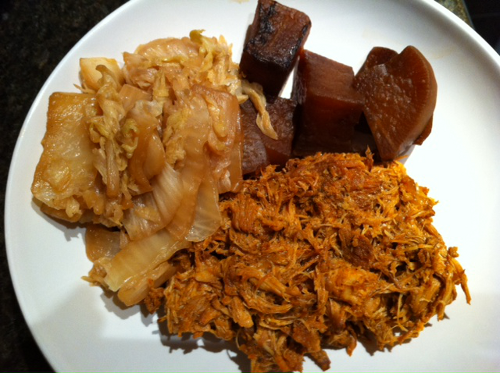
My dinner on Thursday Night: pulled chicken thighs cooked in the slow cooker with Crystal hot sauce and Walden Farm Honey BBQ Sauce, Japanese radishes boiled in soy sauce, and stir-fried Napa (chinese) cabbage
The options are really endless. There are so many recipes (e.g. eggplant lasagna, coconut pancakes, and flax muffins) that you could easily cook a large batch of in a few hours and eat for the week. I like to cook several different dishes so that I can have variety during the week, but how many you cook is up to you.
Low Carb Ice Cream Part 1 – FAIL
Low carb desserts are definitely the weak link in the locarbolicious diet! And, unfortunately, my search for an edible low carb ice-cream has so far lead me nowhere. In fact, it’s really a disgrace to call the frozen foods that I’m going to describe below “ice-creams” because they bear so little resemblance in taste to them! If you don’t believe me, you’re welcome to go try them, but just remember that you’ve been warned! There’ll be a part 2 to this as I’ve got a few more ideas to try before giving up!
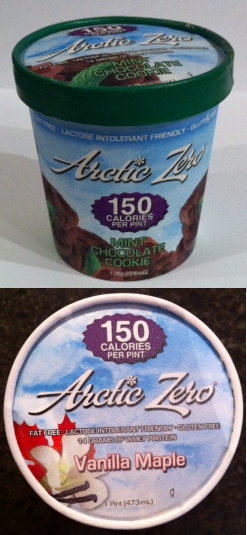 Arctic Zero: You know, they do such an amazing job of advertising their 150 calories per pint fake ice-cream, that I’ve actually been fooled twice into buying it! I somehow forgot just how awful it tasted after my first purchase (the mint chocolate cookie), and so when I saw it again in Wholefoods, I was fooled AGAIN (I bought the vanilla maple flavor that second time)! So, what is this Arctic Zero that’s able to fool me twice? It’s not ice-cream in any way (even though they call it an “ice-cream replacement”) – it has no milk or cream in the ingredients list. At best, it might be described as a bad sorbet perhaps. It’s true that their ingredients list looks pretty “natural,” but “natural” does not equal good tasting! On the contrary, their main ingredient is purified water (which, if you forgot, tastes like nothing). Their second most populous ingredient is whey protein concentrate, which also does not taste good (that’s why you have to flavor protein shakes so much!). Then comes a whole slew of sugars and flavorings, including organic cane sugar, chicory root, guar gum, xantham gum, natural flavors, sea salt, monk fruit concentrate. These are definitely not ingredients for the low carb purists! Ok, enough about the ingredients, the truth is I just care about whether it tastes good!
Arctic Zero: You know, they do such an amazing job of advertising their 150 calories per pint fake ice-cream, that I’ve actually been fooled twice into buying it! I somehow forgot just how awful it tasted after my first purchase (the mint chocolate cookie), and so when I saw it again in Wholefoods, I was fooled AGAIN (I bought the vanilla maple flavor that second time)! So, what is this Arctic Zero that’s able to fool me twice? It’s not ice-cream in any way (even though they call it an “ice-cream replacement”) – it has no milk or cream in the ingredients list. At best, it might be described as a bad sorbet perhaps. It’s true that their ingredients list looks pretty “natural,” but “natural” does not equal good tasting! On the contrary, their main ingredient is purified water (which, if you forgot, tastes like nothing). Their second most populous ingredient is whey protein concentrate, which also does not taste good (that’s why you have to flavor protein shakes so much!). Then comes a whole slew of sugars and flavorings, including organic cane sugar, chicory root, guar gum, xantham gum, natural flavors, sea salt, monk fruit concentrate. These are definitely not ingredients for the low carb purists! Ok, enough about the ingredients, the truth is I just care about whether it tastes good!
How does it taste? Because most of the pint is just frozen water, it doesn’t have the creaminess of ice-cream. Instead, it’s closer to ice, which presents a slight challenge when you’re trying to scoop it out. You could of course wait for it to melt a bit, but then it turns into a slushy frozen fudge-like consistency, which tastes even worse. I prefer the taste when this so called “ice-cream” is frozen because I can at least pretend that it’s just flavored ice or something! The mint flavor smells ok – mint + chocolate. The taste though, was just a watery mess. It was kind of minty and kind of maybe chocolatety and vaguely sweet. The vanilla maple was even worse – maybe vanilla and maple just doesn’t work well together, I don’t know, but all I can say was yuck!
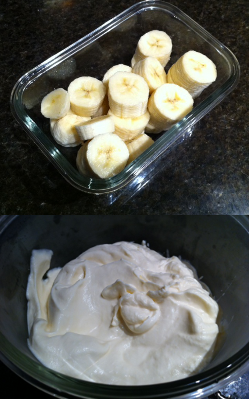 Bananas: You might have heard of this trick already, but after you put frozen bananas through the blender, they come out looking very much like creamy ice-cream. You can easily try this yourself by getting 2 bananas (you need enough bananas in the blender for it to have something to blend otherwise it doesn’t work) and chopping them up into half-inch chunks (as shown in the top picture). Place the chunks of bananas into the freezer overnight (it doesn’t work if the bananas are not well-frozen as I found out on my first attempt, which resulted in a disgusting gooey mess). Then place the frozen banana chunks into the blender and blend well for a few minutes – at first it looks like it’s just chopping the frozen bananas into smaller frozen chunks, but after a while, you’ll see the “ice-cream” form (see photo).
Bananas: You might have heard of this trick already, but after you put frozen bananas through the blender, they come out looking very much like creamy ice-cream. You can easily try this yourself by getting 2 bananas (you need enough bananas in the blender for it to have something to blend otherwise it doesn’t work) and chopping them up into half-inch chunks (as shown in the top picture). Place the chunks of bananas into the freezer overnight (it doesn’t work if the bananas are not well-frozen as I found out on my first attempt, which resulted in a disgusting gooey mess). Then place the frozen banana chunks into the blender and blend well for a few minutes – at first it looks like it’s just chopping the frozen bananas into smaller frozen chunks, but after a while, you’ll see the “ice-cream” form (see photo).
How does it taste? Like bananas (surprised?). It’s kind of creamy, but it’s not really creamy like full fat dairy ice-cream and it has a gooey texture when it melts in your mouth (not surprising since that’s the texture of banana puree). So maybe if you really like banana-flavored, not-so-creamy ice-cream, then this might work! Oh, and it’s not really low-carb since bananas have a lot of carbs. One medium sized banana (7″ to 7-7/8″ long) has 27g carbs (3g fibre and 14g sugar!). So, not a great choice!
Ok, don’t despair just yet as there are a few other options for low carb ice-creams out there. I’m going to try and get my hands on a tub of the Carbsmart Breyers Ice-cream (their website claims that Food Emporium carries one of the Carbsmart ice-creams). And then there’s also the trial and errors of home-made ice-cream. Part 2 coming soon… If you’ve tried a low carb ice-cream, please comment below to let me know what you thought of it.
Low Carb Cereal
Update: I got tired of the No Low Carb Cereal situation I originally wrote this post about and created my own Low Carb, No Grains/Gluten, No-Added Sugar Breakfast Cereal (it’s 100% all-natural and is called Breakfast Bites)! It looks like breakfast cereal, tastes like breakfast cereal, but is Low Carb (3g net carbs per serving). You can get it at Louise’s Foods. So now I can’t complain about the lack of low carb cereal at breakfast anymore 🙂
_______________________________________________________________________________
Why can’t I eat a nice bowl of low carb cereal for breakfast instead of these eggs and bacon? I’m always in a rush in the mornings, so breakfast options are low. I’m not even a huge fan of corn flakes or anything, but after a while, some low carb cereal sounds delicious. Some crunchy flakes covered with fresh cold milk. Yum! So what options are there in terms of cereal? A quick internet search yields some disappointing and some interesting options.
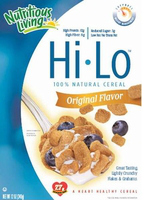 First there’s Hi-Lo cereal. Although it’s marketed as a low carb cereal, it fails in many aspects to convince me that I should even give it a try! First, there’s the ingredient’s list – soy, wheat gluten, corn and rice flour – not a great combination when many low carb diets recommend no grains! Then there’s their net carb count – 7g per 1/2 cup serving, and I’m betting a 1/2 cup serving would not be sufficient for me to starve off the hunger until lunch. Having said all that, it is still lower than other cereals. For example, corn flakes (plain) contains approximately 12g of carbs per 1/2 cup, so it’s definitely an improvement. Some consumers on Amazon seem to really like their Maple Pecan flavor, although others seem to think it’s a bit “bland” and tastes like “cardboard.” Regardless, it’s not on my list!
First there’s Hi-Lo cereal. Although it’s marketed as a low carb cereal, it fails in many aspects to convince me that I should even give it a try! First, there’s the ingredient’s list – soy, wheat gluten, corn and rice flour – not a great combination when many low carb diets recommend no grains! Then there’s their net carb count – 7g per 1/2 cup serving, and I’m betting a 1/2 cup serving would not be sufficient for me to starve off the hunger until lunch. Having said all that, it is still lower than other cereals. For example, corn flakes (plain) contains approximately 12g of carbs per 1/2 cup, so it’s definitely an improvement. Some consumers on Amazon seem to really like their Maple Pecan flavor, although others seem to think it’s a bit “bland” and tastes like “cardboard.” Regardless, it’s not on my list!
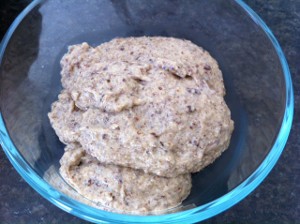 Then there’s a variety of low carb hot cereals, mostly made from flax. Flax seeds are highly nutritious with lots of omega-3 fatty acids and a ton of fiber. If you grind up the flax seeds (in a coffee grinder or a blender with no water), then it forms a flour, which when mixed with water forms an oatmeal-like consistency. Here’s a simple recipe (from about.com) for a hot nutty oatmeal-like cereal that you can make at home.
Then there’s a variety of low carb hot cereals, mostly made from flax. Flax seeds are highly nutritious with lots of omega-3 fatty acids and a ton of fiber. If you grind up the flax seeds (in a coffee grinder or a blender with no water), then it forms a flour, which when mixed with water forms an oatmeal-like consistency. Here’s a simple recipe (from about.com) for a hot nutty oatmeal-like cereal that you can make at home.
- Pour half a cup of boiling hot water onto a quarter cup of flax seed meal and mix.
- Add in two tablespoons of almond butter (or peanut butter or some other nut butter) with a quarter teaspoon of cinnamon (optional).
- You can also add in a drop of liquid sucralose or a small amount of stevia to sweeten it.
I made the pictured bowl of low carb cereal by using coconut peanut butter, no cinnamon and 3 drops of liquid sucralose. It tasted ok, not completely like oatmeal though. I think the best description for the consistency is oatmeal with a tablespoon of oil coating it. It’s just a bit gluey!
And lastly (yes, I ran out of low carb cereal options very quickly), there’s a low carb hot pumpkin cereal(from about.com again) that I’m going to try soon. The ingredients sound a bit crazy (but the reviews seem to suggest this tastes really good!).
- Take 1/2 cup ricotta cheese and mix it with some water to thin it out (it can be as thin or as thick as you want, although if you plan to add flax seed meal to it, then add more water).
- Use a whisk to beat an egg into the mixture.
- Then add 1/4 cup of pumpkin puree and a pinch of salt. You can also add in cinnamon/nutmeg and sucralose or Stevia.
- Place the mixture into a non-stick pan and heat on a medium heat. The mixture should go “grainy” after a while as the egg cooks, and you can stir in some flax seed meal then.
I’ll let you know when I make this!
Dried Fruit and Vegetable Snacks – Dehydrator Frenzy
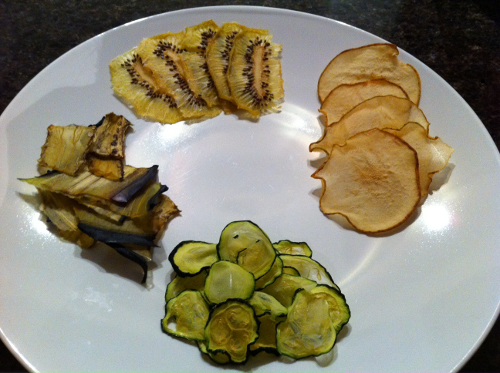
Dried in the dehydrator: (from top clockwise) kiwi, Bartlett pear, zucchini (courgette), eggplant (aubergine)
Dehydrator?? I recently bought a dehydrator, which just dries out various foods like fruits, vegetables, and even meats (think beef jerky). It’s a simple device – it basically blows hot air at your foods until they become dry. It’s reasonably cheap for a food device -mine cost $60 on Amazon. I got the Nesco FD-75PR 700-Watt Food Dehydrator, which comes with 5 trays to place food on and has a variety of temperatures for drying different foods. See the pictures below.
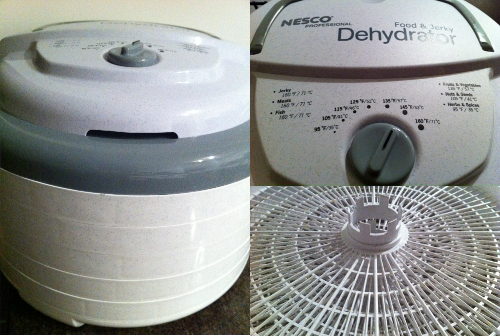
3 Pictures of the Nesco FD-75PR 700-Watt Food Dehydrator
How to Dehydrate Foods? It’s so easy to dehydrate foods. For the veggies, I like to slice them into thin slices (around 1 millimeter thick) so that it doesn’t take too long for them to dry. I also like to salt them, which makes them taste better and helps to dry them faster (you can also try adding spices to them) – so boil some water and add a bunch of salt and dump the sliced veggies into the water for 1 minute. Fish them out quickly before they get too soggy. Then place the slices on the dehydrator. I dehydrated the zucchini and eggplant slices for around 9 hours – it’s a bit of a trial and error game because it was difficult to get the slices the same thickness, and the drying time really depends on how thick the slices are. For pears and kiwis, I cut them into thin, 1-2 millimeter slices. They took a little longer to dehydrate though (probably because they were thicker and didn’t have any salt on them). I put them in for 11 hours, and they came out pretty crispy but still a tad chewy and leathery (so it’s not going to break at the touch).
Why dehydrate fruits and vegetables when they taste perfectly good fresh? There are a variety of reasons for this! First, it allows the foods to stay fresh for much longer, so you can buy of box of apples (which is often cheaper than buying them a few a time – think Costco!) and eat those apples several months later. Then, there’s the variety – the dried fruits and veggies are a great snack that you can take with you anywhere in a small ziploc bag. Also, dehydrated fruits and veggies are “not cooked” so they count as raw food if you’re on the raw food diet. It’s super healthy and tasty. I’ve noticed these kale chips in Wholefoods recently. They cost a fortune (they’re not trying to rip you off – it really just cost a lot to produce them!), but you can make your own by buying some kale, salting it, and dehydrating it!
I started making some dried watermelon slices…
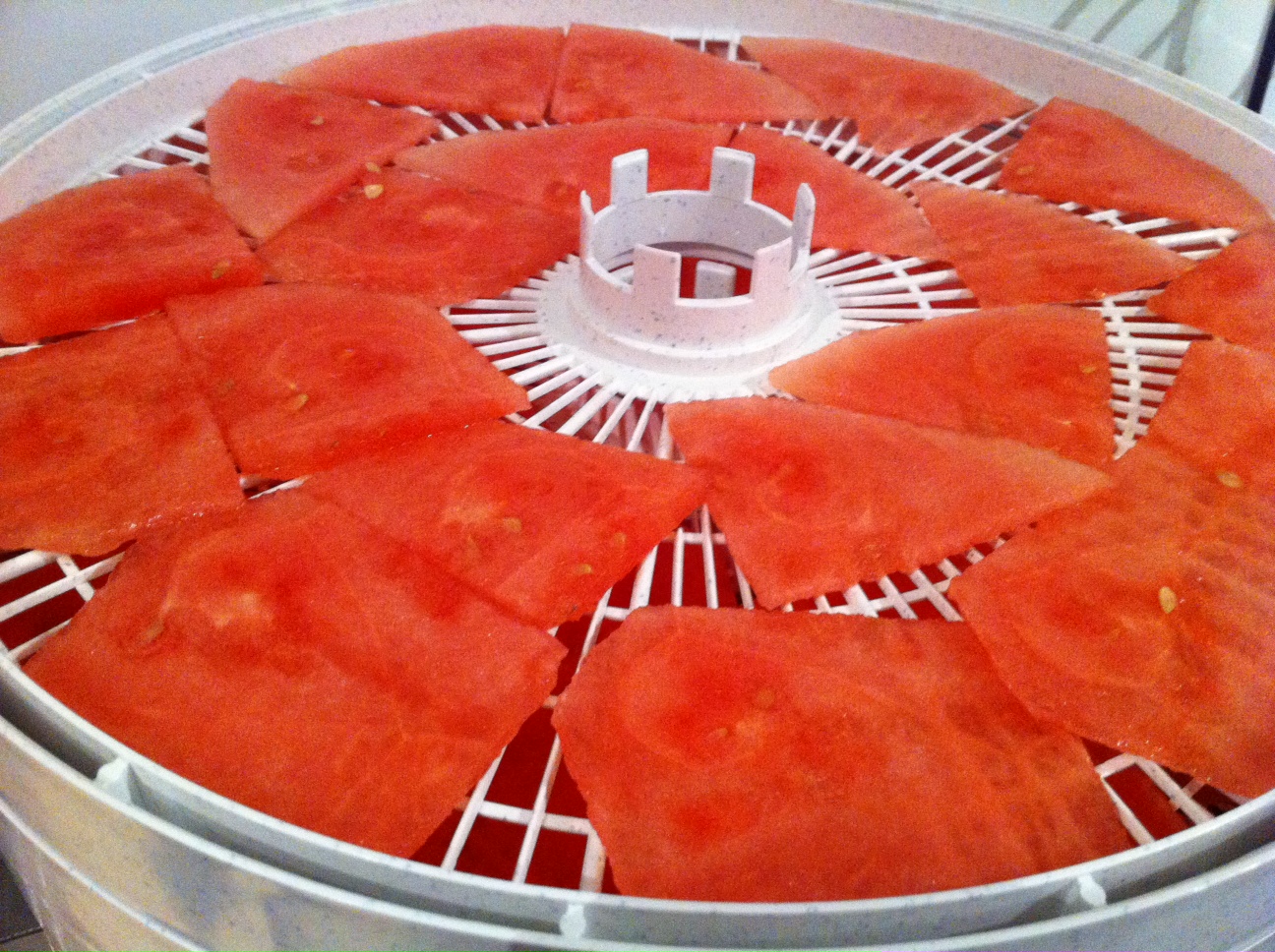
Watermelon sliced thin in the dehydrator (before dehydrating).
Conclusion to Atkins Diet and New Diet Challenge
The Atkins’ Induction diet ended two weeks ago, and since then I’ve been traveling and generally drinking and eating as if these would be my last meals ever! In hindsight, the Atkins’ diet wasn’t so horrific (although I’m sure that’s a result of my selective memory). There was nothing wrong with the diet – it was strict, but doable, and I definitely saw results within those two weeks (I lost 6 lbs and felt so much more awake during the day). The problem only came when I ended the diet.
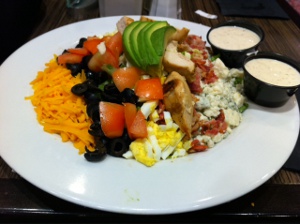 There was the initial joyous anticipation, which started a few days before the diet was scheduled to end, and I didn’t stray from the diet during those few last days even though I had to fly to Atlanta (I dutifully packed some home-made jerky and Atkins’ mudslide bars for the flight and enjoyed a very large salad (see photo) at the airport before the flight). I know, pat pat on the shoulders! Then, there was the day itself – I wasn’t too bad initially (I had a sticky bun at a local brunch place in Woodstock, GA), but then it just fell apart over the following two weeks as more and more carb-full and sugar-packed delights came into my purview. I had everything from milkshakes (including a foie gras one that I did not enjoy) to burgers and doughnuts (the ones at Voodoo Doughnuts in Portland were amazing!). Then I topped it all off with a brioche french toast brunch coupled with butter slathered on moist biscuits (the Southern kind) this morning at Craftbar. Sigh. I knew after the meal that something had to change. I was exhausted and ready to go to sleep at 2pm in the afternoon after having only gotten up two hours previously. This was not how I wanted to spend my previous weekend days.
There was the initial joyous anticipation, which started a few days before the diet was scheduled to end, and I didn’t stray from the diet during those few last days even though I had to fly to Atlanta (I dutifully packed some home-made jerky and Atkins’ mudslide bars for the flight and enjoyed a very large salad (see photo) at the airport before the flight). I know, pat pat on the shoulders! Then, there was the day itself – I wasn’t too bad initially (I had a sticky bun at a local brunch place in Woodstock, GA), but then it just fell apart over the following two weeks as more and more carb-full and sugar-packed delights came into my purview. I had everything from milkshakes (including a foie gras one that I did not enjoy) to burgers and doughnuts (the ones at Voodoo Doughnuts in Portland were amazing!). Then I topped it all off with a brioche french toast brunch coupled with butter slathered on moist biscuits (the Southern kind) this morning at Craftbar. Sigh. I knew after the meal that something had to change. I was exhausted and ready to go to sleep at 2pm in the afternoon after having only gotten up two hours previously. This was not how I wanted to spend my previous weekend days.
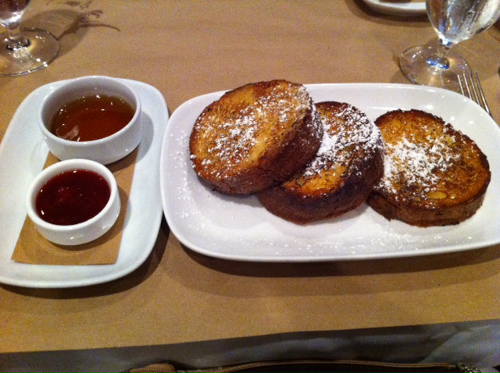
Brioche Pain Perdu (posh name for French Toast made from French bread) from Craftbar, NYC
So, a new challenge. No more eating out for a WHOLE MONTH! It’s going to recharge my energy, boost my health, and increase my bank balance! Friends, if you want to see me for dinner, bring your dinner and come over to eat 😀 I’ll even share some of my food with you! I’d like to say I can do this challenge for longer, but I already have a trip to Chicago planned in mid-October (traveling always seems to screw up my diet as Atlanta and Portland demonstrated!).
And to keep up with my experimentation of low carb diets, I am planning to start Mark Sisson’s Primal diet (a popular version of the Paleo “caveman” diet) next week.
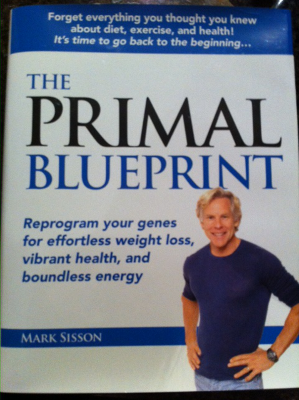
The Primal Blueprint by Mark Sisson, who also writes Mark’s Daily Apple blog
Update on Atkins’ Induction Diet
It’s day 6, and I still haven’t caved in, although I hit a bit of a rocky patch on Tuesday and had to consume 3 Atkins bars in order to keep going! So what have I been eating? Well, it’s been a bit easier since starting back at work on Monday since my office has a cafeteria, although you can get what I’ve been eating for breakfast and lunch in most cities!
For breakfast, I devour 3 fried eggs with some bacon (I’m usually starving by the time I get to work). I’m rather bored by just eggs alone so the bacon helps to add some flavor to things. Omelets and scrambled eggs can make for a bit of a variation. Or if you’re super lazy, you can boil a dozen eggs in one go, peel them and store them in the fridge. Then have 2 or 3 each morning for breakfast. I quite like the taste of caesar salad dressing so you could cut up your eggs with a fork and mix it with some of that for a bit more flavor and less dryness. Also, some soy sauces (or liquid aminos) have 0 carbs (or very small amounts) and can add great flavor to eggs cooked any way! Soy sauce gets mixed responses from Atkins dieters because its ingredient list contains wheat, which is not allowed on the diet. As an alternative to soy sauce, you can try Liquid Aminos, which are made from soybeans and water. Bragg (one manufacturer of liquid aminos) claims that each 1/2 teaspoon contains 0.1g of carbs.
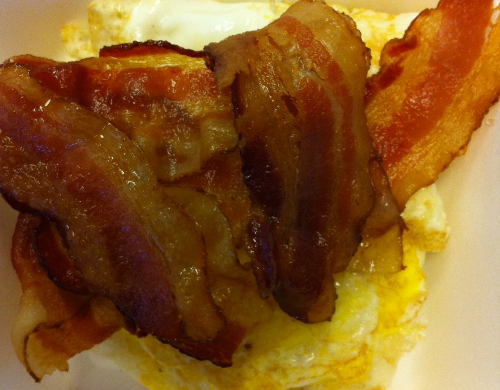 3 Fried Eggs with Bacon Strips
3 Fried Eggs with Bacon Strips
For lunch, I’ve gotten salads several times. I put in some boiled eggs (cut up), some tuna, some onions, and some spinach. I’ve also thrown some olives in a few times. I usually also get a fillet of salmon freshly grilled. I then shred the salmon meat and stick it into my salad. Then everything is tossed with 3 tablespoons of caesar dressing (I say “tossed” but really I just put everything into the box they supply in my cafeteria and shake vigorous!). Several other salad dressings are permitted on the Atkins induction diet including, blue cheese, italian, lemon juice, oil and vinegar, and ranch, although caesar contains by far the least amount of carbs per serving, which means more spare carbs to consume elsewhere during the day! Of course, you don’t have to do salads! I got a grilled hanger steak one day and had it with some veggies. Grilled fish is also good as long as there’s no sauce on it. I often also get some chicken broth to have as a soup – I just skim the liquid off the top of a chicken noodle soup.
 Salad with eggs, tuna, salmon, onions, spinach, and caesar dressing
Salad with eggs, tuna, salmon, onions, spinach, and caesar dressing
So far, this gets me to around 2pm. I can make it most days to around 3pm or 4pm just on the above described breakfast and lunch. However, once that afternoon slump hits, it’s deathly! To get water from the pantry, I have to walk past the vending machine and these chocolate covered almond machines! I can usually make it past the vending machines without incident, but those almonds! They’re just sitting in this glass bowl, and my eyes just stray over to them as I turn the corner out of the pantry. Last time I went to get water, I nearly walked into the wall because my legs kept moving whereas my eyes remained fixed on that delicious sweet sensation! Sigh. That’s when I turn to the Atkins bars. Everyone (except perhaps Atkins) claims that you get the best results if you stay away from the bars. Some people on the diet are purists and want to stay away from anything that might be controversial, including diet sodas, soy sauce, and Atkins bars. I, however, cannot do it. In fact, I was so enamored with those bars that I bought a whole 12-pack of them from Amazon! I really like the Marshmallow Mudslide flavor although the Chocolate Chip Granola Barcomes a close second. There’s a Cookies N Creme bar that’s coming soon, and if I were planning to continue this diet for a while, then I would definitely be eagerly awaiting their release! Of course, there are other snacks, for example, cheese. I bought the Robusto aged gouda from Wholefoods and cut it up into 1 oz pieces (approximately 2 inches by 0.5 inches by 0.5 inches) and individually wrapped them. Then you can take a few pieces into work as a snack. (I had 2 of those pieces as an after dinner snack tonight.)
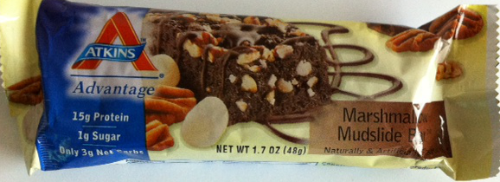 Atkins Advantage Marshmallow Mudslide Bar (allowed for all phases of the Atkins’ diet, but note – contains sugar alcohols)
Atkins Advantage Marshmallow Mudslide Bar (allowed for all phases of the Atkins’ diet, but note – contains sugar alcohols)Dinner…this always perplexes me. I don’t really want to spend ages cooking when I get off work so I usually cobble together a smattering of different dishes that I’ve cooked during the weekend or on a less tiring night. The dishes include salmon salad, egg salad, tuna salad, slow cooker pork belly, slow cooker chicken, and whatever else I can think off that’ll keep in the fridge for a few days (there’s currently a nice slab of beef brisket cooking in my slower cooker). It’s quick, and it gives me some variation – at the very least, my plate looks very colorful!
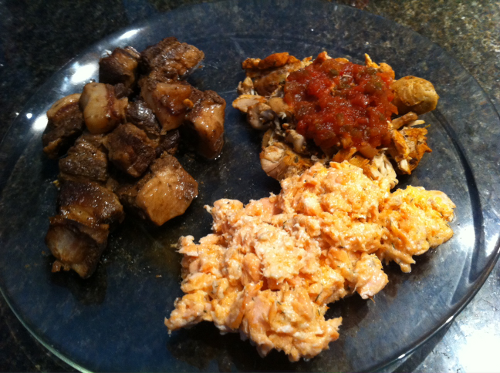 Plate with pork belly, slow cooker chicken with salsa, and salmon salad
Plate with pork belly, slow cooker chicken with salsa, and salmon salad
What do I think so far of the diet? It’s painful! But, because I really don’t have hardly any sugar highs, I never really feel that awful crushing crash when you go off the sugar high. Then, of course there’s the issue of no alcohol. I’m 50/50 on this at the moment – I hate not being able to drink anything except water and soda water at a bar, but yet I’m grateful the next morning when I’m not waking up to a dry mouth and a pounding head! However, I feel that several “celebratory” drinks will be waiting at the end of the next 8 days…
Day 1 of Atkins’ Induction Diet
It’s all very well saying here’s what you can eat and here’s what you can’t eat on this diet, but when it comes down to having to pick out food for eat meal, it’s a lot more problematic. Foods that you normally took for granted are suddenly on the forbidden list. Foods that you thought were low carb turn out to have way more sugar in them than allowed on the diet. Eating the same food day after day is also annoying. So, here is what I’m eating daily on this diet along with my total estimated calorie and carb intake.
Total Carb Count for Day 1: Calories = 1440 Carbs = 7.2g
Day 1 – Breakfast: Scrambled eggs with onions and a side of prosciutto. Calories = 400 Carbs = 4g
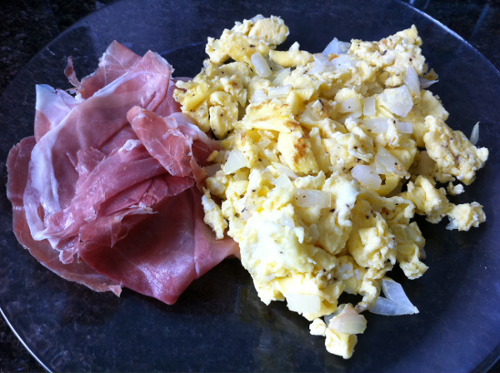
Scrambled eggs with onions and a side of prosciutto (3 eggs)
Day 1 – Lunch: Home-made grass-fed beef patty (lemon infused macademia oil, all-spice, salt). Calories = 380 Carbs = 0g
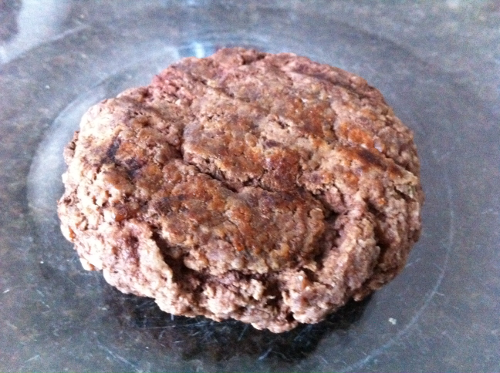
Home-made grass-fed beef patty (lemon infused macademia oil, all-spice, salt)
Day 1 – Afternoon Snack: Atkins Advantage Peanut Fudge Granola Bar. Calories = 210 Carbs = 2g
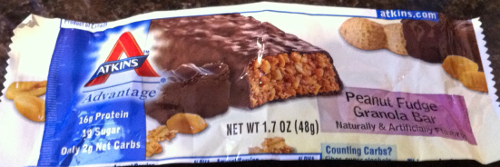
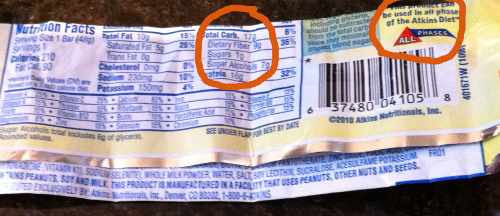
Atkins Advantage Peanut Fudge Granola Bar (allowed for all phases of the Atkins’ diet, but note – contains sugar alcohols)
Day 1 – Dinner: Egg Salad. Calories = 300 Carbs = 1.2g
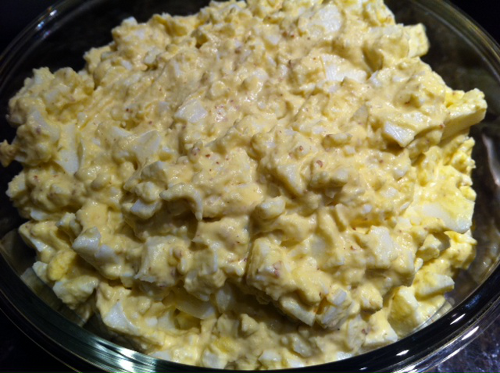
Egg salad made with German mustard, mayo, and salt
Day 1 – Midnight Snack (because I hate going to bed hungry!): Slow-cooker Chicken. Calories = 150 Carbs = 0
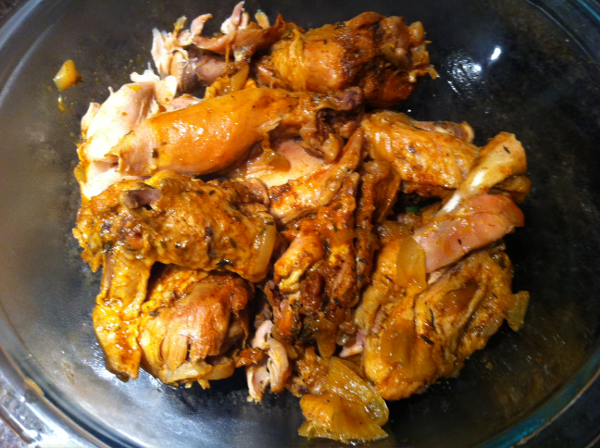
A few small pieces of slow cooker cooked chicken thighs with a tablespoon of paprika, garlic powder, onion, and pinch of salt
Day1 – Drinks: Decaf black tea with coconut milk, Iced Rishi Mint Rooibos tea, and of course lots and lots of water.
Atkins’ Induction Diet – Introduction to the Diet
Today is day 1 of the 2 week challenges and the start of the Atkins induction diet. I did my research by reading the atkins’ diet website and Dr. Robert C. Atkins’ New Diet Revolution book. A large section of the book deals with the science behind the diet – from insulin to metabolic advantage. Then there’s a large chunk of the book that talks in detail about the diet and what you can and cannot eat. The induction diet is the first couple of weeks on the Atkins’ diet (the 1st of 4 phases of the diet). It is also the hardest part of the diet as it contains the most restrictions on what you can and cannot eat. They suggest that most people should go on the induction part of the diet for at least 14 days and that you can see results (I think they’re talking about weight loss here) within that period. Unfortunately, 14 days of this diet is going to be seriously challenging – I currently feel like all I can eat is eggs, steak, and celery!
What Can You Eat on the Atkins’ Induction Diet?
- 20g of Carbs per day: The main premise of the atkin’s diet is carb counting. During the induction phase of the diet, you can consume a maximum of 20 grams of carbohydrates each day – that’s a really small amount!
- Meats: You can eat all meats as long as it doesn’t have any added sugar in the meat itself or in the sauce. There is a caution regarding processed meats (e.g., ham, bacon, salami, hot dogs) because they may contain added sugar.
- Cheeses: You can also eat a small amount of cheese. The book recommends 3-4 oz per day of a full-fat aged cheese. 1 oz of cheese (approximately a chunk 2 inches by 0.5 inches by 0.5 inches) counts as 1 gram of carbs. No cottage cheese, farmer’s cheese or other fresh cheeses are allowed.
- Vegetables: 2 to 3 cups of leafy, watery vegetables such as bok choy, arugula, cucumbers, mushrooms, lettuce, or celery. Vegetables higher in carb content such as asparagus, bamboo, cabbage, broccoli, onion, eggplant, spinach, tomatoes, squash, string beans, zucchinis, pumpkin, kale, and cauliflower may also be consumed, but only 1 cup per day as measured with the raw vegetable.
- Salad Dressing: For salad dressing, avoid prepared dressings and get oil and vinegar (although not balsamic vinegar, which contains huge amounts of sugar as I discovered today at the salad bar!).
- Other Foods: You’re also allowed to have butter and mayonnaise (according to the website) as they both have no carbs. You are also allowed to eat one of the following: 10-20 olives, half a small avocado, an ounce of sour cream or 3 ounces of unsweetened heavy cream per day. For snacks, Atkins snack bars are sold in many stores – I picked up some from a health food store in midtown New York. Make sure that the back of the Atkins bar says that it’s suitable for all phases of the diet as some of the bars are only suitable for phases 2, 3 and 4.
- Fiber: Dr. Atkins also recommends taking in a bit of psyllium husks or ground flaxseeds if you get constipated. I assume this can be a problem since you’re not eating foods with all that much fiber. However, there are some sources that suggest that eating more meat does not lead to constipation in the long run although it may be a problem in the beginning stages of a low carb diet.
What Can You Drink?
Basically anything without caffeine or sugar. The list includes broth, club soda, heavy or light cream (2-3 tablespoons per day), decaf coffee or tea, diet sodas sweetened with sucralose (Splenda), flavored zero-carlorie seltzers, herbal tea, 2-3 tablespoons of lemon or lime juice, and of course water.
What Can You NOT Eat?
Wow, this list is long! It’s basically anything with a lot of carbs in it! But, on the induction diet, you’re also not allowed nuts and fruits, which a lot of other low carb diets allow. The diet also tells you to stay away from certain artificial sweeteners due to harmful effects and recommends Splenda as the best one (max 3 packets a day due to the 1 gram of carbs it has per packet). However, if you’re using liquid sucralose, there should be no restriction as there is no sugar in it at all. Soft fresh cheeses are also not allowed along with other diary products such as milk (which has a fair amount of sugar) and yogurt.
Water and Vitamins
Dr. Atkins recommends drinking plenty of water on this diet (eight 8 oz glasses of water per day). He also believes that we are vitamin and mineral deficient and require some supplements. I recommend the Source Naturals Life Force Multiple as it contains a much better balance of nutrients than other brands.
Don’t Starve! Try the Best Low Carb Diet Instead

“there’s even a tapeworm diet?”
Everyone is searching for the best diet whether to lose weight or to be healthier, and the crackpots (and the doctors) cater to our desires by coming up with the “best,” “easiest,” and “quickest” diets. I often hear of people doing various crazy diets whereby they starve themselves for some specified period of time in the absurd hope that the pain and suffering derived from the starvation will miraculously shave 20lbs of fat from their body permanently. Ok, so I was one of those people once upon a time. I used to religiously check the nutritional information on the back of every product in the supermarket to ensure I was consuming the fewest calories possible. My friends would shake their heads and look at me as if I was crazy, and now I do the same when I hear of someone on the raw food diet or the grapefruit diet (there’s even a tapeworm diet?)!
“I hate being hungry – it’s like waking up on the wrong side of bed for me.”
Although I laugh at “those” people, I would totally also buy into the crazy diets if they had any modicum of success and didn’t involve so much starvation. I hate being hungry – it’s like waking up on the wrong side of bed for me. I often think about doing a fast for a day, but I just know I couldn’t do it – I estimate that I’d last until lunchtime. So basically I pick my diets on how hungry I will be on the diet because there’s a much much higher chance that I will keep with the diet if I’m not continuously starving! The other main advantage of the low carb diet is saying goodbye to that afternoon slump when you just wish you could hid under your desk and take a nap. There’s no sugar high and therefore no sugar crash. You can throw away those 5 hour energy drinks, that triple espresso shot and those cans of diet coke!
“fewer carbs does correspond to more misery (but also more weight loss)”
Stick to the Atkins Diet for Weight Loss: I think the Atkins diet is great if you’re looking to lose weight. There’s a definite plan so you’re not flailing around figuring things out – they tell you what to do and what results to expect, and you get results within 2 weeks! The downside is of course that it is a very strict diet, especially initially. In the first 2 weeks, you have to stick with less than 20g of net carbs a day (basically, you’re eating veggies and meat/eggs all day). After the first 2 weeks, you can gradually increase your carb intake, although not by that much! You can read the Aktins’ diet book for more information about the diet. If you really follow it, you will find the lbs just dropping off. You don’t really get hungry on the diet either because you can pretty much eat as much as you want (just not anything with too much carbs)! In fact, the main problem most people encounter on the diet is not intaking enough protein and therefore starting to lose too much weight! But only do this diet if you’re serious as it’s a difficult diet to stick to in the long run.
“if you’re just looking to lose weight – then Atkins is the way to go”
My Low Carb Diet: Personally, I’m not a big fan of strict diets – it’s too painful! It’s especially painful if you give up carbs completely when you normally consume a huge ton of them daily. I first tried the Atkins diet several years ago during finals – huge mistake! I felt dizzy and unfocused. It was as if my brain had stopped functioning. Eating carbs is basically an addiction, and I suffered withdrawal symptoms when I stopped intaking them even for a day! My advice is to try to cut out carbs gradually – don’t get that mashed potato side with your steak and choose a cheese plate for your dessert instead. Maybe do the 1 cookie a day challenge, where you cut out carbs from all your meals but reward yourself with a cookie during the afternoon each day. However, if you’re just looking to lose weight – then Atkins is the way to go!
What Foods Not to Eat? The main things to avoid on the diet are any kind of bread or pasta (even gluten free ones), anything with sugar (even some sugar-free desserts are off limits) and potatoes. I’ll write a more detailed post about what foods you can and cannot eat on low carb diets soon.
